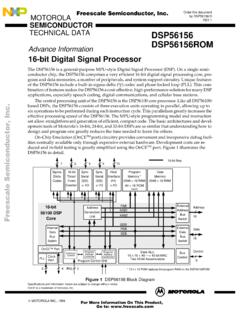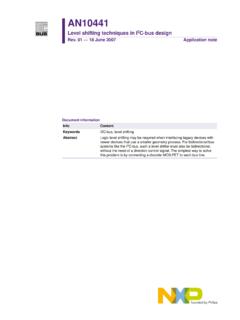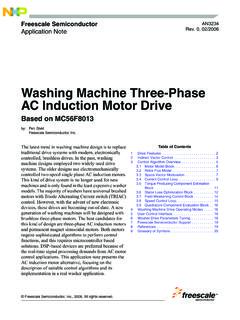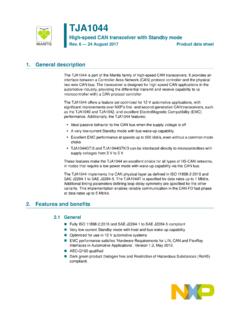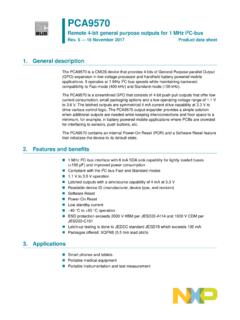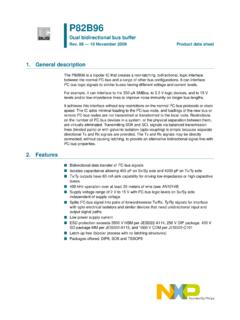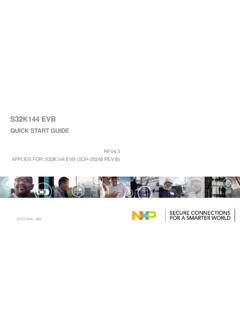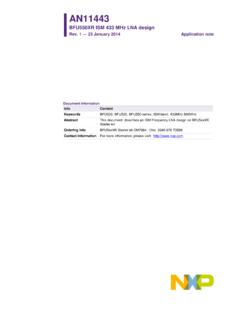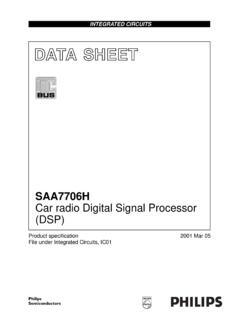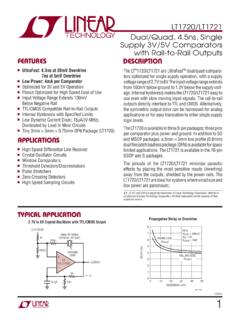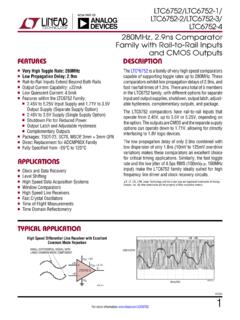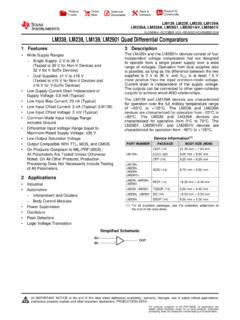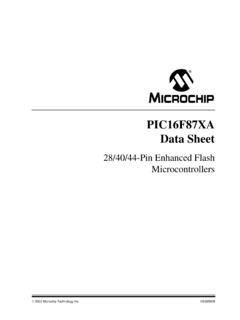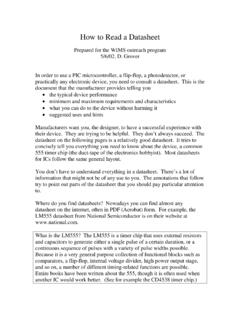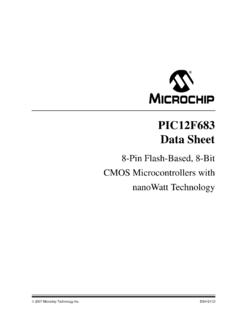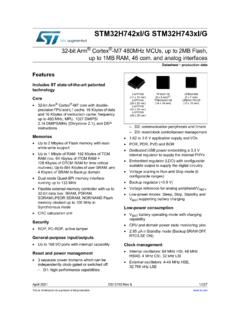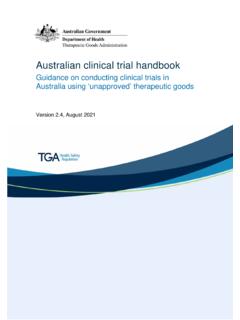Transcription of i.MX RT1170 Crossover Processors Data Sheet for Consumer ...
1 NXP SemiconductorsData Sheet : Technical DataDocument Number: IMXRT1170 CECRev. 2, 11/2021 MIMXRT1176 DVMAAMIMXRT1175 DVMAAMIMXRT1172 DVMAAMIMXRT1171 DVMAAMIMXRT117 HDVMAAMIMXRT117 FDVMAAP ackage InformationPlastic Package289-pin MAPBGA, 14 x 14 mm, mm pitchOrdering InformationSee Table 1 on page 6 NXP reserves the right to change the production detail specifications as may be required to permit improvements in the design of its products. 2020-2021 NXP RT1170 introductionThe RT1170 is a new high-end processor of the RT family, which features NXP s advanced implementation of a high performance Arm Cortex -M7 core operating at speeds up to 1 GHz and a power efficient Cortex -M4 core up to 400 RT1170 processor has 2 MB on-chip RAM in total, including a 768 KB RAM which can be flexibly configured as TCM (512 KB RAM shared with M7 TCM and 256 KB RAM shared with M4 TCM) or general-purpose on-chip RAM.
2 The RT1170 integrates advanced power management module with DCDC and LDO regulators that reduce complexity of external power supply and simplifies power sequencing. The RT1170 also provides various memory interfaces, including SDRAM, RAW NAND FLASH, NOR FLASH, SD/eMMC, Quad/Octal SPI, Hyper RAM/Flash, and a wide range of other interfaces for connecting peripherals, such as WLAN, Bluetooth , GPS, displays, and camera sensors. The RT1170 also has rich audio and video features, including MIPI CSI/DSI, LCD display, graphic accelerator, camera interface, SPDIF, and I2S audio RT1170 Crossover Processors data Sheet for Consumer Products1. RT1170 introduction .. Features .. Ordering information .. Package marking information .. 92. Architectural overview .. Block diagram .. 103. Modules list .. Special signal considerations.
3 Recommended connections for unused analog interfaces .. 224. Electrical characteristics .. Chip-level conditions .. System power and clocks .. I/O parameters .. System modules .. External memory interface .. Display and graphics .. Audio .. Analog .. Communication interfaces .. Timers .. 1025. Boot mode configuration .. Boot mode configuration pins .. Boot device interface allocation .. 1046. Package information and contact assignments .. 14 x 14 mm package information .. 1107. Revision history .. RT1170 Crossover Processors data Sheet for Consumer Products, Rev. 2, 11/20212 NXP RT1170 introductionThe RT1170 is specifically useful for applications such as: Industrial Human Machine Interfaces (HMI) Motor Control Home Appliance High-end Audio Appliance Low-end Instrument Cluster Point-of-Sale (PoS) RT1170 Processors are based on Arm Cortex -M7 Core Platform, which has the following features: The Arm Cortex-M7 Core Platform.
4 32 KB L1 Instruction Cache and 32 KB L1 data Cache Floating Point Unit (FPU) with single-precision and double-precision support of Armv7-M Architecture FPv5 Support the Arm v7-M Thumb instruction set, defined in the Armv7-M architecture Integrated Memory Protection Unit (MPU), up to 16 individual protection regions Up to 512 KB I-TCM and D-TCM in total Frequency of 1 GHz with Forward Body Biasing (FBB) Frequency of the core, as per Table 11, "Operating ranges," on page 27. The Arm Cortex -M4 Core platform: Cortex-M4 processor with single-precision FPU defined by Armv7-M architecture FPv4-SP Integrated MPU with 8 individual protection regions 16 KB Instruction Cache, 16 KB data Cache, and 256 KB TCM Frequency of 400 MHz without body biasingThe SoC-level memory system consists of the following additional components: Boot ROM (256 KB) On-chip RAM (2 MB in total) Configurable 512 KB RAM shared with M7 TCM 256 KB RAM shared with M4 TCM Dedicated MB OCRAM Secure always-on RAM (4 KB) External memory interfaces: 8/16/32-bit SDRAM, up to SDRAM-133/SDRAM-166/SDRAM-200 8/16-bit SLC NAND FLASH SD/eMMC SPI NOR/NAND RT1170 RT1170 Crossover Processors data Sheet for Consumer Products, Rev.
5 2, 11/2021 NXP Semiconductors3 Parallel NOR FLASH with XIP support Single/Dual channel Quad SPI FLASH with XIP support Hyper RAM/FLASH OCT FLASH Synchronization mode for all devices Timers and PWMs: Six General Programmable Timer (GPT) modules 4-channel generic 32-bit resolution timer for each Each supports standard capture and compare operation Two Periodical Interrupt Timer (PIT) modules Four timers for each module Generic 32-bit resolution timer Periodical interrupt generation Four Quad Timer (QTimer) modules 4-channel generic 16-bit resolution timer for each Each supports standard capture and compare operation Quadrature decoder integrated Four FlexPWMs Up to 8 individual PWM channels for each 16-bit resolution PWM suitable for Motor Control applications Four Quadrature Decoders Four Watch Dog (WDOG) modulesEach RT1170 processor enables the following interfaces to external devices (some of them are muxed and not available simultaneously): Display Interface.
6 Parallel RGB LCD interface (eLCDIF) Support 8/16/24-bit interface Support up to WXGA resolution @60fps Support Index color with 256 entry x 24-bit color LUT Parallel RGB LCD Interface Version 2 (LCDIFv2) Enhanced based on LCDIF version Support up to 8 layers of alpha blending MIPI Display Serial Interface (MIPI DSI) PHY integrated 2 data lanes interface with up to GHz bit rate clock Smart LCD Display with 8080 interface through SEMC RT1170 Crossover Processors data Sheet for Consumer Products, Rev. 2, 11/20214 NXP RT1170 introduction SPDIF input and output Four Synchronous Audio Interface (SAI) modules supporting I2S, AC97, TDM, and codec/DSP interfaces Medium Quality Sound (MQS) interface via GPIO pads PDM microphone interface with 4 pairs of inputs Asynchronous Sample Rate Converter (ASRC) Graphics engine: Generic 2D (PXP) BitBlit Flexible image composition options alpha, chroma key Porter-duff blending Image rotation (90 , 180 , 270 ) Image resize Color space conversion Multiple pixel format support (RGB, YUV444, YUV422, YUV420, YUV400) Standard 2D-DMA operation Vector Graphics Processing Real-time hardware curve tessellation of lines, quadratic, and cubic Bezier curves 16x Line Anti-aliasing OpenVG support Vector Drawing Camera Interface.
7 Parallel Camera Sensor Interface (CSI) Support 24-bit, 16-bit, and 8-bit input Barcode binarization and histogram statistics MIPI Camera Serial Interface (MIPI CSI) PHY integrated 2 data lanes interface with up to GHz bit rate clock Connectivity: Two USB OTG controllers with integrated PHY interfaces Two Ultra Secure Digital Host Controller (uSDHC) interfaces eMMC compliance with HS400 support up to 400 MB/sec SD/SDIO compliance with 200 MHz SDR signaling to support up to 100 MB/sec Support for SDXC (extended capacity) One 10M/100M Ethernet controller with support for IEEE1588 One Gigabit Ethernet controller with support for AVB One Gigabit Ethernet controller with Time Sensitive Networking (TSN) RT1170 RT1170 Crossover Processors data Sheet for Consumer Products, Rev. 2, 11/2021 NXP Semiconductors5 Twelve universal asynchronous receiver/transmitter (UARTs) modules Six I2C modules Six SPI modules Three FlexCAN (with Flexible data -rate supported) modules Two EMV SIM modules Analog: Two Analog-Digital-Converters (ADC), which supports both differential and single-end inputs One Digital-Analog-Converter (DAC) Four Analog Comparators (ACMP) GPIO and Pin Multiplexing: General-purpose input/output (GPIO) modules with interrupt capability Input/output multiplexing controller (IOMUXC) to provide centralized pad control Two FlexIO modules 8 x 8 keypadThe RT1170 Processors integrate advanced power management unit and controllers.
8 Full PMIC integration, including on-chip DCDC and LDOs Temperature sensor with programmable trim points Hardware power management controller (GPC)The RT1170 Processors support the following system debug: Arm CoreSight debug and trace architecture Trace Port Interface Unit (TPIU) to support off-chip real-time trace Cross Triggering Interface (CTI) Support for 5-pin (JTAG) and SWD debug interfacesSecurity functions are enabled and accelerated by the following hardware: High Assurance Boot (HAB) Cryptographic Acceleration and Assurance (CAAM) module: Public Key Cryptography Engine (PKHA) Symmetric Engines Cryptographic Hash Engine Random Number Generation (RNG4) Four Job Rings for use by Processors Secure Hardware-Only Cryptographic Key Management Encrypted Boot Revision control check based on fuse values DEK includes IV Side channel attack countermeasures 64 KB secure RT1170 Crossover Processors data Sheet for Consumer Products, Rev.
9 2, 11/20216 NXP RT1170 introduction Inline Encryption Engine (IEE): External memory encryption/decryption I/O direct encrypted storage and retrieval (Stream Support) FlexSPI decryption only On-the-Fly AES Decryption (OTFAD): AES-128 Counter Mode On-the-Fly Decryption Hardware support for unwrapping key blobs Functionally acts as a slave sub-module to the FlexSPI Secure Non-Volatile Storage (SNVS): Secure real-time clock (SRTC) Zero Master Key (ZMK) Secure always-on RAM (4 KB) Secure key management and protection Physical Unclonable Function (PUF) UnDocumented Function (UDF) Built-in Manufacturing Protection Hardware Secure and trusted access controlNOTEThe actual feature set depends on the part numbers as described in Table 1. Functions such as display interfaces, camera interfaces, and connectivity interfaces are not offered on all informationTable 1 provides examples of orderable part numbers covered by this data 1.
10 Ordering informationAttributeMIMXRT1176 DVMAAMIMXRT1175 DVMAAMIMXRT1172 DVMAAMIMXRT1171 DVMAAMIMXRT117 HDVMAAMIMXRT117 FDVMAAQ ualification tierConsumerM7 core1 GHzM4 core400 MHz400 MHz 400 MHz SRAM2 MBParallel LCD and CSIYe s Ye s Ye sYe sMIPI DSI and CSIYe s Ye s Ye sYe sGPU2 DYe s Ye s Ye sYe sPXPYe s Ye s Ye sYe RT1170 RT1170 Crossover Processors data Sheet for Consumer Products, Rev. 2, 11/2021 NXP Semiconductors7 Figure 1 describes the part number nomenclature so that characteristics of a specific part number can be identified (for example, cores, frequency, temperature grade, fuse options, and silicon revision). The primary characteristic which describes which data Sheet applies to a specific part is the temperature grade (junction) field. The RT1170 Crossover Processors for Consumer Products data Sheet (IMXRT1170 CEC) covers parts listed with a D ( Consumer temp) ADCx212-bit DACx1 ACMPx41 Gb ENET with AVBx11 Gb ENET with TSNx1 x1 10/100 Mb ENET with 1588x1 USB OTGx2eMMC / SD SIMx2 SAIx4 DMICx8 FlexSPIx2 UARTx12I2Cx6 SPIx6 GPTx6 PITx2 QTimerx4 FlexPWMx4Te m p M o n i t o rx1 SecurityYe sPackage289 MAPBGA, 14 mm x14 mm, mm pitchJunction temperature Tj ( C)0 to 95 Table 1.
